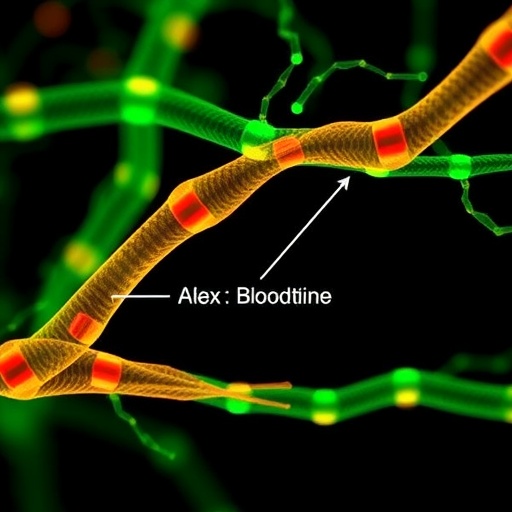In an era where the barriers of medical innovation are continually pushed, the realm of engineered human tissues stands as a beacon of promise for modern medicine. These artificial constructs, designed to mimic the function and behavior of human tissues, play a critical role in preclinical testing of new drugs, regenerative medicine, and understanding complex biological phenomena. Recent research spearheaded by a dynamic collaborative team at Binghamton University has unveiled breakthrough techniques in constructing artificial vascular systems that could accelerate the development and viability of these engineered tissues.
The inherent challenges within the domain of tissue engineering often stem from the necessity of blood circulation within these artificial constructs. Blood flow is essential for providing nutrients and oxygen to cells, enabling their survival and functionality. However, consistently maintaining a functional vascular system within three-dimensional structures poses significant hurdles. Without an adequate vasculature, engineered tissues can quickly succumb to necrosis, rendering them ineffective for research or therapeutic applications.
In the recent publication featured in the journal Biomedical Materials, Assistant Professors Ying Wang and Yingge Zhou, along with a dedicated team of doctoral students and postdoctoral researchers, have showcased innovative approaches utilizing advanced nanomanufacturing techniques. Their research primarily focuses on the creation of a sophisticated vascular system that could be integrated seamlessly into engineered tissues. This advancement not only addresses existing limitations but also paves the way for future explorations into organ-specific tissue scaffolds.
One of the most compelling aspects of their research lies in the multi-tiered approach to vascular design. Wang articulated that their engineered vascular construct mimics the hierarchical architecture seen in natural vascular systems. Notably, they synthesized larger blood vessels analogous to our aorta and main veins, while simultaneously employing spontaneous self-assembly for the creation of smaller arteries. This sophisticated strategy exemplifies a pivotal leap in the design of vascular networks, as it allows flexibility in creating varied blood vessel sizes according to functional requirements.
Furthermore, the researchers have harnessed two commonly used inert compounds in biomedical devices, polyethylene oxide (PEO) and polystyrene (PS), to fabricate microtubes. These microtubes serve as an essential component in their engineered tissues, promoting enhanced nutrient distribution and oxygen flow. The technique they employed, known as electrospinning, enabled the production of ultra-fine fibers at an unprecedented scale. This method is especially critical, as 3D printing techniques often struggle to achieve the resolution required for such minute structures.
Zhou elaborated on the specifics of their fabrication process, detailing how they created microtubes that measure between 1 to 10 microns. To put this into perspective, a single micron is one-millionth of a meter. The typical human hair is approximately 70 to 100 microns thick. Thus, managing the precision at this microscopic scale is a considerable technical achievement, necessitating sophisticated methods like electrospinning to create solid microtubes, which are then hollowed out by dissolving their cores.
The integration of these finely crafted fibrous tubes into a composite hydrogel forms a vital part of the medium used for tissue growth. The collaborative team adeptly utilized fluorescent microbeads to track blood flow within the engineered tissue, revealing that the incorporation of these microtubes significantly improved blood distribution. As a result, cells within the constructed tissues received the necessary nutrients and oxygen, ultimately expanding their viability for further research and applications.
Binghamton University’s research team anticipates novel avenues of exploration as they look to further understand how alterations in the dimensions and configurations of these microtubes could influence vascular outcomes. Additionally, they aim to develop specialized microvasculature that mimics the characteristics of specific organs, such as the complex blood-brain barrier. This pursuit is particularly crucial, as comprehending the intricacies of the blood-brain barrier is key to advancing treatments for various neurological conditions, including tumors and neurodegenerative diseases.
The overarching goal of this groundbreaking research is to enhance the physiological relevance of engineered tissues, making them more representative of actual human biology. Wang underscored the potential of their work, expressing a vision where perfected vascular technology could lead to the assembly of entire organ systems mimicking living, functional human tissues. Achieving this milestone would revolutionize tissue engineering, allowing for personalized medicine approaches and advanced studies that significantly improve health outcomes.
With the intense focus on organ-specific applications, the future of this research appears bright and filled with potential. The next steps will likely involve rigorous examinations of how microstructural adjustments impact tissue performance and how these findings can be applied to clinical settings. The implications of this research extend far beyond the laboratory, heralding a new era of personalized healthcare where engineered tissues could be used not just for drug testing but also for repairing damaged organs and tissues in real patients.
In conclusion, the collaborative efforts at Binghamton University highlight a major advancement in the quest for effective engineered tissues, offering hope for myriad applications in regenerative medicine and drug development. With the right resources and continued research, the integration of sophisticated vascular networks within artificial tissues could indeed transform the way we approach health and disease, making significant strides towards a healthier future.
Subject of Research: Human tissue samples
Article Title: Engineering polystyrene microtube-embedded composite hydrogels for tunable vascular morphogenesis
News Publication Date: 18-Jul-2025
Web References: Link to Journal
References: Biomedical Materials journal article
Image Credits: Jonathan Cohen/Binghamton University
Keywords
Biomedical engineering, tissue engineering, vascular systems, nanomanufacturing, organ-specific scaffolds.




